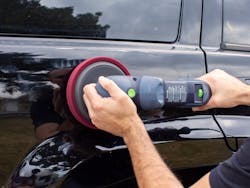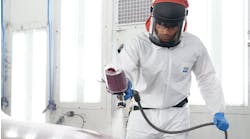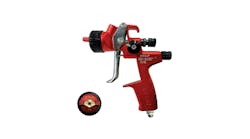For decades, the rotary polisher has been the tool of choice in body shops the world over. It’s also been the go-to tool at dealerships, for professional detailers, custom car builders, and anyone else who wanted to make paint shine. Let’s face it; there just aren’t any real alternatives. Or are there?
Detailers and enthusiasts have been using dual action (DA) polishers for the past 20 years to accomplish a similar goal – shiny paint – but with obvious limitations. Really heavy defects ranging from severe etching due to bird droppings, heavy scratches, and advanced oxidation were just too much for a DA polisher to handle. And those sanding marks from body shop finishing? Forget it. That was primarily because those early DA polishers were adapted from tools originally designed as sanders for working on wood. And just as with pneumatic DA sanders used in a body shop, they had a short stroke length and not much torque. Of course, you want a shorter stroke for finer sanding. And you just don’t need a lot of torque for that application, either, so it made sense. But with the right pads and chemicals, you could take a decent paint finish and make it look much nicer overall even with those early tools.
How technology has improved DA polishers for the body shop
As with almost everything else in this world, technology has changed DA polishers in a dramatic way. Technology has also allowed for advancements in pads and compounds. So, when you pair these with the latest generation of DA polishers, you get what can be a viable alternative to the rotary polisher, and not just because of the power and torque. It takes much less time to master the DA polisher, or at least to become proficient enough to get excellent results the majority of the time. This is partly because the DA polisher is a much more forgiving tool than the rotary. Use a DA incorrectly and you fail to reach the target goal. Use a rotary wrong, though, and you run the risk of burning or striking through the paint very quickly. While it is not impossible to do this with a DA, you have to work at it to create this sort of damage.
But can the DA really find a useful place in a body shop? With taller stroke tools commonly offering 21mm of stroke length and plenty of torque to keep the pad rotating when in contact with curved body panels, the answer is now a definite yes! Modern compounds and microfiber pads or discs play a large role in this as well, as they offer a faster cut and the ability to carry a higher abrasive load to the paint than foam pads do. Add all this up, and it’s a straightforward process to remove 2000 grit or finer sanding marks. If a body shop is making use of the latest sanding disc technology offering 3000, 5000 or even 8000 grit options, you can quickly buff out these marks.
A rotary can remove these finer sanding marks quickly as well, so why even consider adding a DA polisher to the mix? Again, the short learning curve and increased safety should be a big motivator, especially for new hires who may not have the experience with rotary tools. At the very least, a DA is the perfect way to remove any rotary swirls that may have come about during the initial compounding step. And it is impossible to create that type of swirl mark with a DA due to the motion of the pad. This can ensure that the finished project is delivered to the customer looking its very best.
How to adapt a rotary user to a DA polisher
One of the biggest challenges for experienced rotary users is the change in technique needed to adapt to the DA. This technique difference is often what has seasoned pros believing that the DA is nothing more than a wax applicator.
First, the pad must be held as flat to the paint surface as possible to ensure that rotation isn’t compromised. Unfortunately, many seasoned pros have a tendency to tip the pad at an angle when using a rotary. Secondly, moving the tool across the paint surface must be done in a slow and methodical manner to ensure that the entire surface area is being treated equally. This movement tends to be much slower than what most rotary users are generally used to.
Next, the size of the work area must be kept fairly small – roughly two square feet – to further maintain that equal treatment across the panel.
Lastly – and this one really bothers longtime rotary users – is the amount of pressure that is needed with a DA polisher. Yes, pressure: as in, pressing down on the tool in order to achieve uniform contact with the paint and increase the overall aggressiveness of the pad and liquid combination. This does not mean that a technician should put their body weight into the tool, but rather impart firm downward pressure on the head of the tool while polishing.
All of these simple technique changes become a challenge simply because a seasoned technician does all of this through muscle memory. They don’t really think about what they’re doing. Their body has become so accustomed to the process that it becomes natural. It’s sort of like walking; nobody really thinks about how to take forward steps; we just do it. Transitioning from a rotary to a DA means a technician now needs to think about what they’re doing and essentially learn to walk again. Fortunately, the similarities between the two tools are strong enough to make this relearn relatively easy.
To reach the desired goal, how does the time investment for each tool differ? At first, it may seem that the rotary still has an advantage here. When you take into consideration the quality of finish that can be obtained by the DA, especially the lack of swirl marks that need to be dealt with in a second step, in many cases the rotary process may actually be longer from start to finish.
So, is it time for you to consider, or maybe reconsider, adding a DA polishing process into your routine? Taking into account the short learning curve with very little risk of costly damage to the paint, the excellent finish quality easily obtained, and the speed of work done, it just may be.





